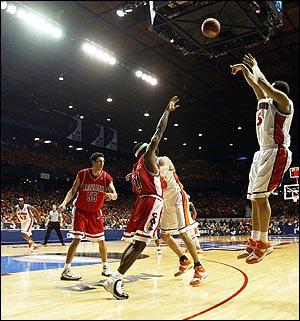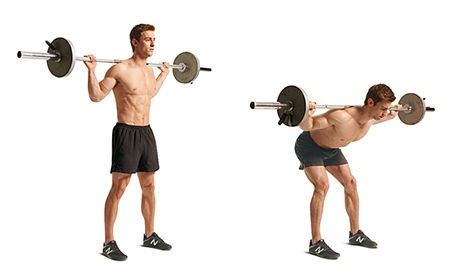
BASKET-BALL Specific Strength and Conditioning Workout for Athletes | Training & Exercises|
|
High Performance : - Foundational training Macrocycle
High Performance : - Functional training Macrocycle
|
|
Youth Performance : - Foundational training Macrocycle
Youth Performance : - Functional training Macrocycle
Youth Performance : - In-Season training MacrocycleYouth Performance : - Pre-Season training Macrocycle |
|
|
Try these progressions and build your way up to the full workouts.
Here are specific workouts. For each workout I’ve included a couple ideas on modifications. Start with what you’re able to do and make a plan to work your way up to this level – it won’t happen overnight but it won’t happen at all if you never begin!
Absolute or Maximal Strength
- Absolute strength is the maximum force that a muscle group can exert in a single, momentary contraction. For example, a player who can bench press 200lbs has greater absolute strength than a player who can bench press 180lbs.
- As a basketball player it's important that you devote a portion of your strength program to developing maximal strength. Why? Because it serves as a foundation for muscular power and speed.
- But there is one condition...
- Maximal strength (usually measured by one repetition max) makes no allowances for time - a weightlifter can spend 20-30 seconds lifting a weight inch by inch.
- That's next to useless in basketball. The ground contacts in most explosive movements (like jumping and sprinting) occur in less than a second!
- So maximal strength training is simply a means to an end (still a very important one though). And the end is to increase your explosive speed and muscular power...
Muscular Power
- Power is a combination of both absolute strength and speed of movement.
- Increase either one (without reducing the other) and you increase explosive power.
- As we'll see in a moment, strength training for basketball should fall into some distinct phases over the course of a season. If you can build a high level of maximal strength first, you can then convert much of those gains into explosive power.
- A very effective form of power training is called plyometrics or jump training - and it's ideally suited to basketball.
- Plyometrics combines elements of both speed and strength in single movement patterns. But you must have a solid strength base before you move on to these types of sessions.
Muscular Endurance
- Your ability to perform repeated, high-intensity movements without fatigue is a reflection of your muscular endurance.
- Improvements in muscular endurance will improve your ability to repeat sprints up and down the court in quick succession. It will also improve your ability to jump several times in succession with minimal loss in power.
- So how do you develop maximal strength, muscular power and muscular endurance all at the same time?
The 4 Phases of Strength Training for Basketball
Bodybuilders and weight lifters tend to follow a progressive weight training program. They just keep increasing the weight indefinitely always striving to lift just a little bit more.
Strength training for basketball should be periodized. What exactly does that mean?
Over the course of a year, strength training for basketball should follow several distinct phases or cycles. Each of these phases has a very specific objective that leads you naturally into the next phase of training.
Follow a periodized strength regime and you'll maximize your results. Plus, here's the kicker...
Unless you're an elite basketball player, very few of your opponents will take this approach to their strength training routine. That gives you a real competitive advantage.
Let's have a look at each phase one by one...
Off-Season - Build Functional Strength
Before you begin the more intensive strength training for basketball, it's crucial that you prepare your body.
During the off-season, and even the early pre-season, begin by performing functional exercises that focus on stabilizing muscles and in particular, core stability...
Basketball places a lot of uneven strains on your body. You throw predominantly with one arm for example. Some joints and tendons are placed under more stress than others. The same muscles are used over and over and grow strong while others are neglected.
A low-intensity functional strength phase helps to restore the balance. So the goals of this phase are:
- To prepare joints, ligaments and tendons for more intense work in subsequent training phases.
- To strengthen neglected stabilizer muscles.
- To balance the right and left side of the body.
- To correct any imbalance between flexors and extensors (the pectorals and triceps may become overly strong in relation to the rhomboid and biceps for example).
In this phase, dedicate a good deal of your time to strengthening your center of power...
The muscles of the trunk and lower back connect the upper and lower body. They support every twisting, turning, jumping and lateral movement. They are literally the link through which all movement passes.
This is the most important phase in strength training for basketball.
Yet most players and coaches dismiss it. And it becomes doubly important for younger players.
The foundations you lay in the off-season and early pre-season literally determine the quality of strength and power you can form in later phases. Not to mention how likely you are to avoid or suffer acute and chronic injury.
- Days per week: 2-3
- Load: 50-60% 1 rep max
- Reps: 15-20
- Sets: 2-3
Off-Season/Early Pre-Season - Build Maximal Strength
Preparing fully makes maximal strength training that much more productive.
Your goal now is peak strength. Then you can convert it into muscular power through plyometric training. Aim to complete this phase at least 4 weeks before the start of the competitive season.
Most basketball players (in fact most athletes) never progress past this phase. They keep lifting more and more weight until they get injured or burnt out. But that's good news for you.
Three strength training sessions a week is enough to build maximal strength. Try to separate each session by 48 hours.
- Days per week:3
- Load: 80-90% 1 rep max
- Reps: 4-8
- Sets: 3-5
Late Pre-Season - Convert to Muscular Power
Now it all starts to come together.
You've taken the time to prepare. You've worked hard to build a high level of strength. Now it's time to reap all the rewards on the court.
Use plyometric training to convert your newfound strength into basketball-specific power. Focus on the lower body with rebounding exercises like depth jumps and work the upper body with medicine balls.
A quick word to the wise however...
Plyometric training is a relatively simple concept but you MUST get it right. Excellent form is essential. So is restricting yourself from overdoing it...
Plyometrics is not physically challenging - not in the sense that wind sprints are. You will probably feel like you haven't done enough. Resist any temptation to do extra. Plyometric training is NOT about "no pain-no gain"!
- Days per week:2-3
- Load: bodyweight only
- Reps: 8-12
- Sets: Varies but never more than 120 ground contacts per session. See guidelines on above link.
In-Season - Maintain Muscular Power
Accept that over the course of the competitive season you will lose some maximal strength. But don't worry about that...
As long as you maintain the high levels of muscular power you've worked so hard to attain, you'll be a better player.
During the in-season spend 1 or 2 sessions in the weight room and 1 or 2 sessions on plyometric training.
Here's how strength training for basketball might look over a 12-month period

